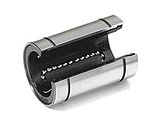Straight line
A straight guide or linear guide is a mechanical guide element that can be used to move a component against another component (often the machine frame ) on a straight line ( translational movement ) . It consists of a stationary part with the guide axis or shafts and a movable slide.
A straight line created with the coupling of a linkage is called a straight line guide .
construction
The guiding principle is defined by three elements: linear bearings, bearing housings and precision shafts. The bearing serves to reduce friction and offers a guide that is as free of play as possible; the length of the shaft defines the stroke of the linear guide. The bearing housing connects the bearing to the slide.
Embodiments
Cross head
(between two horizontal slide rails) of a steam locomotiveStraight guidance of a machine tool table, two round rods and bushes
Straight guidance of a machine tool table, two prismatic tracks, needle roller bodies
The first two images show sliding linear bearings. The second picture shows two standard radial slide bearings with two degrees of freedom of movement (f = 2). The second mobility is canceled by the doubling.
The last two figures show typical linear bearings with rolling elements. The machine tool table moves on needle rolling elements on two rails. Since a form fit in the prism tracks prevents rotation, both rails could in principle be combined into one. The last picture shows a recirculating ball bushing as a component that characterizes linear technology. The rolling balls remain in the socket, in which they are returned in separate channels. A linear ball bearing (also called shaft guides) ensures low-friction guidance.



